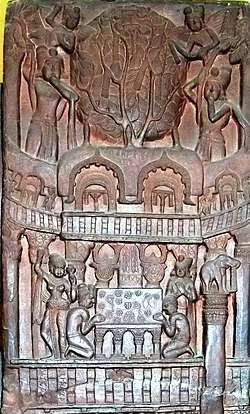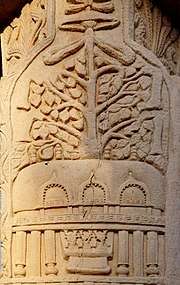Buddhist temple
A Buddhist temple or Buddhist monastery is the place of worship for Buddhists, the followers of Buddhism. They include the structures called vihara, chaitya, stupa, wat, and pagoda in different regions and languages. Temples in Buddhism represent the pure land or pure environment of a Buddha. Traditional Buddhist temples are designed to inspire inner and outer peace.[1]
| Part of a series on |
| Buddhism |
|---|
 |
|
|
Architecture
Its architecture and structure varies from region to region. Usually, the temple consists not only of its buildings, but also the surrounding environment. The Buddhist temples are designed to symbolize five elements: fire, air, earth, water and wisdom.[2]
India
The design of temples in India was influenced by the idea of a place of worship as a representation of the universe. For Buddhist temple complexes one tall temple is often centrally located and surrounded by smaller temples and walls. This is symbolic of Buddhist imagining of the universe with Mount Meru at the center surrounded by oceans, lesser mountains and a huge wall.[3]
A Chaitya, Chaitya hall or Chaitya-griha refers to a shrine, sanctuary, temple or prayer hall in Indian religions. The term is most common in Buddhism, where it refers to a space with a stupa and a rounded apse at the end opposite the entrance, and a high roof with a rounded profile. Strictly speaking, the chaitya is the stupa itself, and the Indian buildings are chaitya halls, but this distinction is often not observed. Many of the early Chaitya were rock-cut, as in Karla caves or Ajanta.

Some of the earliest free-standing temples may have been of a circular type. Ashoka also built the Mahabodhi Temple in Bodh Gaya circa 250 BCE, a circular structure, in order to protect the Bodhi tree under which the Buddha had found enlightenment. The Bairat Temple is also a round structure, which can be seen through archaeological remains. Representations of this early temple structure are found on a 100 BCE relief sculpted on the railing of the stupa at Bhārhut, as well as in Sanchi.[4] From that period the Diamond throne remains, an almost intact slab of sandstone decorated with reliefs, which Ashoka had established at the foot of the Bodhi tree.[5][6] These circular-type temples were also found in later rock-hewn caves such as Tulja Caves or Guntupalli.[7]

 Bodhi tree temple depicted in Sanchi, Stupa 1, Southern gateway.
Bodhi tree temple depicted in Sanchi, Stupa 1, Southern gateway. Remains of the circular rock-hewn circular Chaitya with columns, Tulja Caves.
Remains of the circular rock-hewn circular Chaitya with columns, Tulja Caves.
Indonesia

In contemporary Indonesian Buddhist perspective, Candi refers to a shrine, either ancient or new. Several contemporary viharas in Indonesia for example, contain the actual-size replica or reconstruction of famous Buddhist temples, such as the replica of Pawon and Plaosan's perwara (small) temples. In Buddhism, the role of a candi as a shrine is sometimes interchangeable with a stupa, a domed structure to store Buddhist relics or the ashes of cremated Buddhist priests, patrons or benefactors. Borobudur, Muara Takus and Batujaya for example are actually elaborate stupas.
In modern Indonesian language, the term candi can be translated as "temple" or similar structure, especially of Hindu and Buddhist faiths. Thus temples of Cambodia (such as the Angkor Wat), Champa (Central and Southern Vietnam), Thailand, Laos, Myanmar and India are also called candi in Indonesian.
Japanese Buddhism
-112516.jpg)
Japanese Buddhist temples typically include a Main Hall.
A distinctive feature is the chinjusha, a Shinto shrine devoted to the temple's kami. Buddhism co-existed with shintoism, but in the 8th century Buddhism became the state religion and Buddhist temples were built.
See also
References
- "New York Buddhist Temple for World Peace". Kadampanewyork.org. 1997-08-01. Archived from the original on 2012-06-11. Retrieved 2012-06-20.
- "Buddhism: Buddhist Worship". BBC. 2006-04-10. Retrieved 2017-03-06.
- O'Riley, Michael Kampel (2013). Art Beyond the West. Person Education. p. 61.
- "Sowing the Seeds of the Lotus: A Journey to the Great Pilgrimage Sites of Buddhism, Part I" by John C. Huntington. Orientations, November 1985 pg 61
- Buddhist Architecture, Huu Phuoc Le, Grafikol, 2010 p.240
- A Global History of Architecture, Francis D. K. Ching, Mark M. Jarzombek, Vikramaditya Prakash, John Wiley & Sons, 2017 p.570ff
- Buddhist Architecture, Huu Phuoc Le, Grafikol, 2010 p.233-237
- Hardy, Adam (1995). Indian Temple Architecture: Form and Transformation : the Karṇāṭa Drāviḍa Tradition, 7th to 13th Centuries. Abhinav Publications. p. 39. ISBN 9788170173120.
- Le, Huu Phuoc (2010). Buddhist Architecture. Grafikol. p. 238. ISBN 9780984404308.